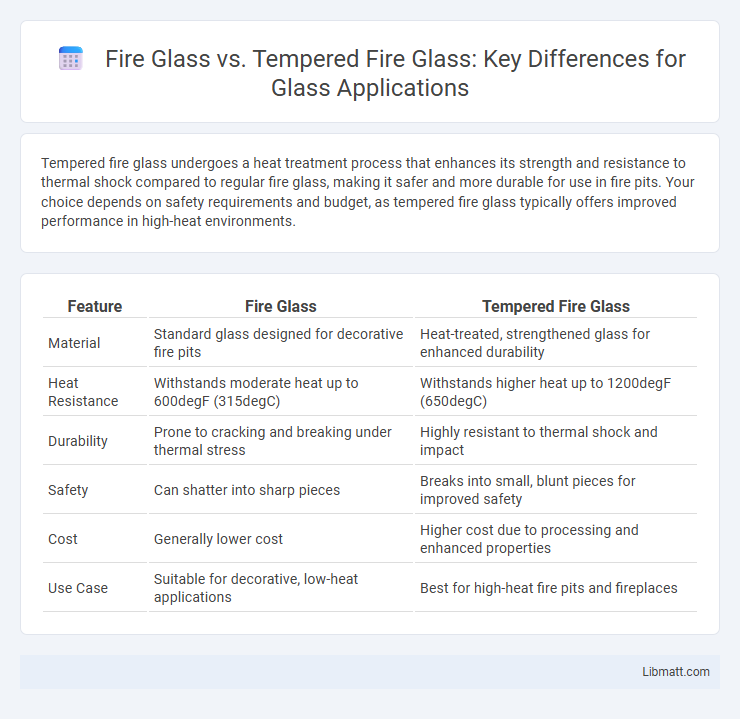Tempered fire glass undergoes a heat treatment process that enhances its strength and resistance to thermal shock compared to regular fire glass, making it safer and more durable for use in fire pits. Your choice depends on safety requirements and budget, as tempered fire glass typically offers improved performance in high-heat environments.
Table of Comparison
| Feature | Fire Glass | Tempered Fire Glass |
|---|---|---|
| Material | Standard glass designed for decorative fire pits | Heat-treated, strengthened glass for enhanced durability |
| Heat Resistance | Withstands moderate heat up to 600degF (315degC) | Withstands higher heat up to 1200degF (650degC) |
| Durability | Prone to cracking and breaking under thermal stress | Highly resistant to thermal shock and impact |
| Safety | Can shatter into sharp pieces | Breaks into small, blunt pieces for improved safety |
| Cost | Generally lower cost | Higher cost due to processing and enhanced properties |
| Use Case | Suitable for decorative, low-heat applications | Best for high-heat fire pits and fireplaces |
Understanding Fire Glass: An Overview
Fire glass consists of tempered glass pieces that are heat-resistant and designed to withstand high temperatures without melting or emitting smoke. Tempered fire glass undergoes a special heat treatment process to increase its strength and safety, reducing the risk of shattering when exposed to intense heat. Your choice between fire glass and tempered fire glass impacts durability, safety, and aesthetic appeal in fire pits or fireplaces.
What Is Tempered Fire Glass?
Tempered fire glass is specially treated fire glass that undergoes a heat tempering process to enhance its strength and durability compared to standard fire glass. This heat treatment makes tempered fire glass resistant to high temperatures, thermal shock, and impact, ensuring safety and longevity in fire pits or fireplaces. Your fire glass choice impacts the safety and performance of your fire feature, with tempered fire glass offering superior resilience and reliability.
Key Differences Between Fire Glass and Tempered Fire Glass
Fire glass consists of decorative, tempered glass pieces designed to enhance fireplace aesthetics, offering high heat resistance and durability. Tempered fire glass undergoes an additional heat-treatment process to increase its strength, making it less likely to shatter or break under thermal stress. The key differences lie in the manufacturing process, enhanced safety, and increased impact resistance of tempered fire glass compared to standard fire glass.
Safety Features: Fire Glass vs Tempered Options
Tempered fire glass offers enhanced safety features due to its heat-resistant properties and ability to shatter into small, less harmful pieces upon impact, reducing injury risk. Regular fire glass, while visually appealing, lacks the structural strength and breakage safety of tempered variants, making it less suitable for high-temperature or high-impact environments. Choosing tempered fire glass ensures compliance with safety standards and greater durability in fire pit applications.
Heat Resistance and Durability Comparison
Tempered fire glass offers superior heat resistance compared to standard fire glass, enduring temperatures up to 1,200degF without cracking. Its enhanced durability results from a strengthening process that increases resistance to thermal shock and impact, making it ideal for high-heat applications. Your fire feature will benefit from tempered fire glass's longevity and safety under intense heat conditions.
Aesthetic and Color Varieties
Fire glass offers a sleek, reflective surface available in a broad spectrum of colors, enhancing the visual appeal of fireplaces and fire pits with vibrant hues and polished finishes. Tempered fire glass undergoes heat treatment, resulting in increased durability and safety without compromising the variety of aesthetic options, including frosted, reflective, and tinted pieces. Both types maintain brightness and color integrity even under high temperatures, making them ideal for decorative and functional fire features.
Installation Guidelines for Each Type
Fire glass installation requires a non-combustible base and careful placement to ensure even heat distribution and avoid fractures. Tempered fire glass, designed to withstand higher temperatures and impact, allows for direct installation in fire pits or fireplaces, but still necessitates proper clearance from flammable materials. Your choice impacts installation techniques, as tempered fire glass demands stringent safety measures to maintain durability and heat resistance.
Performance in Outdoor and Indoor Fire Features
Fire glass offers vibrant aesthetics and heat resistance suitable for both indoor and outdoor fire features, but tempered fire glass enhances safety with greater durability and shatter resistance under extreme temperature fluctuations. Tempered fire glass withstands the rapid heating and cooling cycles common in outdoor environments better than regular fire glass, reducing the risk of breakage and maintaining performance over time. Indoor fire features benefit from the sleek appearance of both types, yet tempered fire glass provides added reliability and longevity in residential settings.
Maintenance and Cleaning: What’s Required?
Fire glass requires regular cleaning to remove soot, dust, and debris that can accumulate and dull its appearance, typically involving rinsing with water and mild soap. Tempered fire glass offers enhanced durability, making it less prone to chipping or cracking during maintenance, which often entails similar cleaning methods but with less frequent replacement. Your choice between the two should consider the ease of upkeep and longevity, as tempered fire glass reduces maintenance frequency while maintaining a sparkling, safe fire feature.
Choosing the Right Glass: Which Is Best for Your Fire Feature?
Tempered fire glass offers enhanced safety and durability due to its heat-treated process, making it more resistant to thermal stress and breakage compared to standard fire glass. Regular fire glass, while visually appealing, lacks the reinforced strength of tempered variants and may crack under high temperatures. Opting for tempered fire glass ensures longevity and safety, especially in high-heat or frequently used fire features.
fire glass vs tempered fire glass Infographic

 libmatt.com
libmatt.com